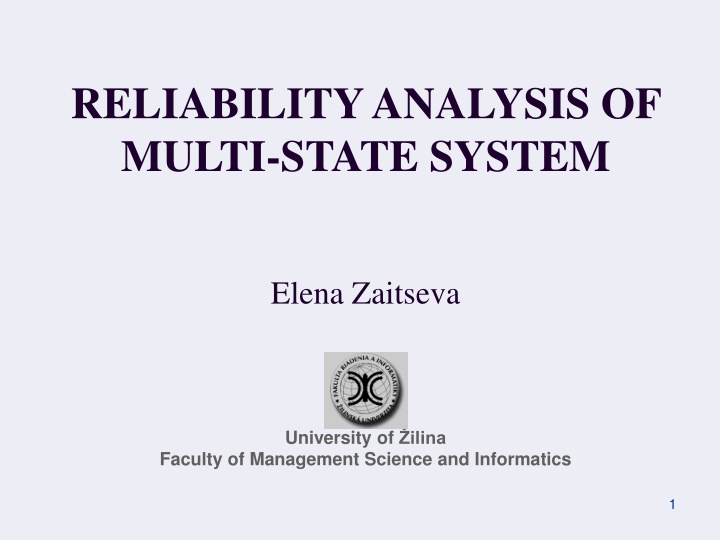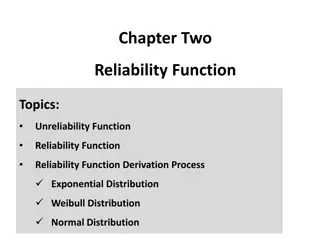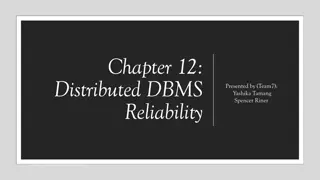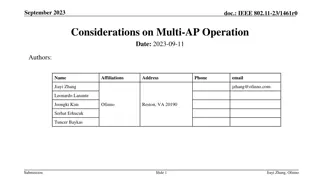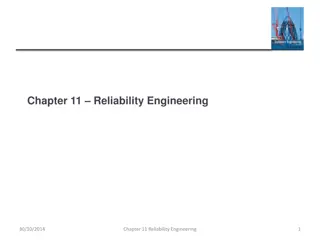Reliability Analysis of Multi-State Systems in Engineering
Analysis by Elena Zaitseva on the quantification of uncertainty in the behavior of multi-state systems, including binary-state and multiple-state systems. Discusses the principal problem in reliability engineering, the quantification of system models, and the structure function defining system performance levels. Highlights challenges and methods for reliability estimation in multi-state systems using mathematical models and algorithms.
Download Presentation

Please find below an Image/Link to download the presentation.
The content on the website is provided AS IS for your information and personal use only. It may not be sold, licensed, or shared on other websites without obtaining consent from the author.If you encounter any issues during the download, it is possible that the publisher has removed the file from their server.
You are allowed to download the files provided on this website for personal or commercial use, subject to the condition that they are used lawfully. All files are the property of their respective owners.
The content on the website is provided AS IS for your information and personal use only. It may not be sold, licensed, or shared on other websites without obtaining consent from the author.
E N D
Presentation Transcript
RELIABILITY ANALYSIS OF MULTI-STATE SYSTEM Elena Zaitseva University of ilina Faculty of Management Science and Informatics 1
Principal Problem in Reliability Engineering Need [1]: the representation and modelling of the system; the quantification of the system model; the representation, propagation and quantification of the uncertainty in system behaviour. [1] Zio E. (2009). Reliability engineering: Old problems and new challenges, Reliability Engineering and System Safety, 94(2), pp.125-141 2
Quantification of the System Model There are two types of mathematical model in Reliability Analysis: Binary-State System (BSS) Multiple-State System (MSS). System reliability Perfect functioning Functioning Partly functioning Completely failed Real-world system Multi-State System Binary-State System 3
Multi-State System (Structure Function) x1 MSS x2 x2 x2 0 1 0 1 x1 0 1 x1 0 1 2 0 1 1 2 0 1 1 1 2 3 BSS x2 0 x2 x2 1 0 1 2 0 1 2 x1 0 1 x1 0 1 2 x1 0 1 2 0 1 1 1 0 1 2 1 1 2 2 2 2 0 1 1 1 2 2 1 2 2 4
Multi-State System (Structure Function) The structure function is the mathematical description of the MSS and declares a system performance level (reliability/availability) depending on its components states: (x1, , xn) = (x): {0, ..., m1-1} ... {0, ..., mn-1} {0, ..., M-1} xi components state (i = 1, , n); n number of system components. The structure function of the BSS: (x): {0, 1}n {0, 1} 5
Multi-State System Principal problem in MSS reliability analysis: Dimension New algorithms and methods for the MSS estimation n 1 = m or m n Dimension of the MSS structure function: i i Methods for the MSS reliability estimation: the extension of the Boolean methods to the multi-valued case; the stochastic process (mainly Markov and semi-Markov); the universal generation function approach the Monte-Carlo simulation 6
Multi-State System Multiple-Valued Logic Principal problem in MSS reliability analysis: Dimension New algorithms and methods for the MSS estimation The use of The extension of the Boolean methods to the multi-valued case the Multiple-Valued Logic for the MSS Dimension Multi-Valued Decision Diagram (MDD) New algorithms and methods Logical Differential Calculus Direct Partial Logic Derivatives Zaitseva, E., Levashenko, V.: Importance Analysis by Logical Differential Calculus. Automation and Remote Control, 74(2), pp. 171 182 (2013) 7
Graphical representation of MSS (MDD) x2 x1 0 1 2 0 1 2 2 2 2 x1 1 0 x1 2 0 1 1 1 2 2 x2 x2 1 x2 1 x2 1 0 0 0 2 2 2 1 2 2 2 2 0 1 2 1 0 x1 2 1 CASE (x1, a, b, 2) a = CASE (x2, 0, 1, 2) b = CASE (x2, 1, 1, 2) x2 x2 0 2 2 0 1 1 0 1 2 8
Graphical representation of MSS (MDD) Basic computational rules in MDD Multiplication Addition Multiplication and Addition pksk pksk pwsw pksk pksk pwsw xi xi si1 si1 pisi1 xi xi si1 si1 pisi1 xi pisi2 si si pisi2 pisi pisi pksk pisi pksk (pisi2+ pisi1) Pisi (pksk+ pwsw) pisi2+ pisi1 pksk+ pwsw 9
MSS: Reliability Function Reliability Function (RF), R(j) is probability that system reliability is great than or equal to the working level j: Rj= Pr{ (x) j}, j (1, , m-1} The system state is define as the probability of the j-th performance level of the system: R(j) = Pr{ (x) = j}, j (1, , m-1} The system unreliability is defined as: F = R(0) = 1 - R(j) = Pr{ (x) = 0} 10
MSS: Reliability Function R(j) = Pr{ (x) = j}, j {1, , m-1} x1 0 The level 1 of system reliability System failure The level 2 of system reliability 2 1 x2 x2 2 2 0 0 1 1 x1 x1 x1 0 0 1 2 0 0 1 2 1 pi,0= 0.1 x2 x2 x2 x2 pi,1= 0.3 0 2 1 0 1 pi,2= 0.6 0 1 2 R(1) = 0.84 F = 0.01 R(1) = 0.15 E. Zaitseva, Importance Analysis of a Multi-State System Based on Multiple-Valued Logic Methods. A.Lisnianski and I.Frenkel (eds.), Recent Advances in System Reliability: Signatures, Multi-state Systems and Statistical Inference, Springer, 2012, pp. 113-134. 11
Importance Measures Multi-State System Importance Measures (IMs) are probabilities characterizes: that the i-th component if the i-th system component state changes how change system reliability 12
Importance Measures There are next IMs: Structural importance Birnbaum importance; Fussell-Vesely measure; Performance reduction worth; Performance achievement worth; Dynamic reliability indices. 13
Direct Partial Logic Derivative in Reliability Analysis of MSS Direct Partial Logic Derivatives of a function (x) with respect to variable xiis defined as: m-1, if (ai, x)=j & (bi, x)=h 0, in the other case. (j h)/ xi(a b) = where j, h, a, b {0, , m-1} . If p=1 this derivatives is the Direct Partial Logic Derivative with respect to one variable. 14
Calculation of Direct Partial Logic Derivative for MSS (m=3, n=2) Direct Partial Logic Derivative of the structure function allows to examine the influence the state change of i-th component into the system reliability. (x) (1 0)/ x1(1 0) 0 0 0 2 0 0 0 0 0 x1x2 0 0 0 0 1 2 1 0 1 x1=1 x1=0 0 2 1 0 1 0 x1 (x)=1 (x)=0 1 1 2 2 2 1 1 x2 1 2 x2=0 2 0 2 1 2 2 15
Structural Measures Structural Importance is one of the simplest measures of component importance, because it ignores any consideration of the individual reliability of components; instead it concentrates on the topological structure of the system. 16
Structural Measures SI, is the proportion of working states of the system in which the working of component i makes the difference between system failure and system working: , s j = ( | ) I s j i s i ... m m 1 n Where is,jis number of system states when the i-th system component state change from s to s-1 results the system reliability level change from j to j-1 and this number is calculated as numbers of nonzero values of Direct Partial Logic Derivative (j j-1)/ xi(s s-1) 17
Structural Measures MSS (1 0) x(1 0) x1x2 (x) x1 0 1 2 1 1 2 2 2 2 0 0 0 1 0 2 1 0 0 0 0 2 0 0 0 0 0 x2 1 , 1 1= 1 , 1 1 1 = 1 ( 1) 1 , Is ) 1 , 1 ( 1 = 2 ) 1 , 1 ( 1 1 1 1 2 2 0 2 1 2 2 Is(11,1) =0.5 Pf(12,1) =0.5 18
Conclusion Multivalued Decision Diagram Multiple-Valued Logic Reliability Analysis Direct Partial Logic Derivatives New algorithms for MSS reliability estimation
Thank you for attention University of ilina Faculty of Management Science and Informatics Department of Informatics Elena Zaitseva 20 E-mail: Elena.Zaitseva@fri.uniza.sk
